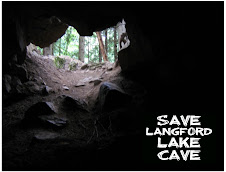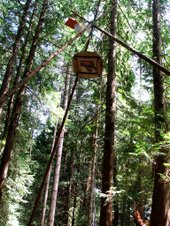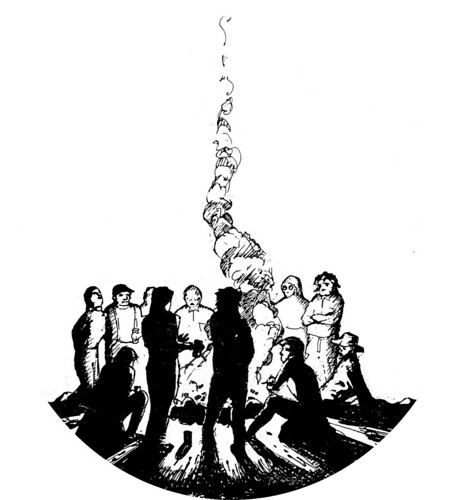 April 11 - I’m standing at the base of the tree leaning back on my harness and peering at the platform sixty feet above. Ingmar is encouraging me to get up there. The press conference is supposed to start in forty-five minutes and we need to get into position. Ingmar’s fully informed about my slightly spastic condition and I can tell he’s not sure if I can still do this. I give him a thumbs up and start up the rope.
April 11 - I’m standing at the base of the tree leaning back on my harness and peering at the platform sixty feet above. Ingmar is encouraging me to get up there. The press conference is supposed to start in forty-five minutes and we need to get into position. Ingmar’s fully informed about my slightly spastic condition and I can tell he’s not sure if I can still do this. I give him a thumbs up and start up the rope.
By the time the camera crews arrive, we’re both up on the platform with our feet dangling down. The cameras focus in as Ingmar rappels down the rope. I stay up in the tree. The CH TV guy comes over with a microphone and battery pack and attaches them to the end of the rope. I haul the rope up and clip the mike to my coat collar. The reporter calls her questions up to me and I shout back down at her, forgetting about the mike.
The reporters and cameras finally leave and I’m alone up in the tree. The platform is a pair of four by eight foot plywood sheets reinforced with two by fours. It looks like a raft on the open ocean. Ropes and rigging are everywhere and the white tarps billow in the wind like sails. The plywood planks are not quite level and they creak and sway as I move around.
It’s a two-room platform: one plank is the bedroom, with a tiny tent nailed to it. The other serves as the living room (a folding chair) and kitchen (a camp stove and a pot). The bathroom is a bucket hanging below the tree-sit. Everything is lashed down or clipped in, but things fall overboard anyway: two pens, my lighter, the lid to my thermos.
I’m tied to the tree on a ten-foot leash tethered to my harness that stays on every moment, even when I’m sleeping. The thing wraps itself around my legs every time I turn around and threatens to knock small untethered objects off the platform.
I’m afraid of falling. Everyone is; people are hardwired that way. Even though I have total confidence in the platform and the safety line, that giddy feeling comes and goes, especially when I’m moving around close to the edge or getting ready to descend down the rope.
There’s a constant wind up here and the roar of traffic is louder. Through the trees to the south I can just make out a bare knoll and the entrance to the Langford Cave, a 40-meter-long karst cavity that draws cavers from all over the region.
The Songhees First Nation named this place Spaet Mountain. The city of Langford calls it Skirt Mountain. The developer has re-named it Bear Mountain to go along with the marketing of their resort and property sales.
A pileated woodpecker flies into the grove of dead snags next to the platform and lands on a trunk at eye level. It hammers away at the wood for a few moments and then swoops over the trail and up a rotten stump. A hummingbird zips by, flashing green. The forest floor is carpeted with trillium and lilies.
As night falls, the traffic dies down and the frogs start up. The tree sways slightly in the wind and the thrushes sing their evening songs. I crawl into the tiny tent and curl up in my sleeping bag, tugging at the tether every time I turn over. Waking up in the middle of the night, I hear an owl hooting.
Thursday morning, the sun is rising through the trees and a winter wren is scolding me nearby. I crawl out of my cocoon, bleary-eyed, and go through the routine of making a pot of tea, taking a shit in the bucket, rolling a cigarette and surveying the forest. I feel wonderful.
People come to visit: local supporters, more journalists, and curious neighbours. Food donations are piling up under a tarp Ingmar tied up for a base camp. The food has to be dealt with because there are raccoons (and possibly bears) in the area, so I haul it up to the platform and make a space in a gear bag for cans of soup, noodles, oatmeal, and cookies.
Cheryl Bryce, the lands manager for the Songhees First Nation, stops by to lend her support and videotape the tree-sit. She’s disturbed that some members of the band council are supporting the development rather than voting to protect the environmental values of their traditional territory. I come down the rope and we chat for a half an hour.
The clouds gather and an icy wind picks up. I go to bed early, snuggled down in the bottom of the sleeping bag with an extra fleece blanket.
Friday dawns with threatening clouds. Then a threatening little man with a mustache: the lands manager for the Provincial Capitol Commission. He’s been sent to determine whether I’m on PCC land, and to grumble at me about the commission’s liability if someone gets hurt and sues them. I promise I won’t hurt anybody and I won’t sue anybody. He suggests if I’m trespassing, he may get the police involved. I invite him to the salmon barbecue scheduled for later tonight. He studies me for a minute without responding and then marches off into the forest with his maps in hand.
I don’t know if he’ll call the police, but even if they show up, they won’t be able to arrest me because I’m sixty feet up in a tree. The RCMP in Vancouver has a special climbing team for these kind of situations, but it takes a few days to assemble. I contemplate the legal implications of criminal trespass charges and court injunctions.
Later: I’m bored, so I use my borrowed cell phone to call the developers’ head office. Bear Mountain Resort and Bear Mountain Properties are the forces behind this project and I figure it’s only polite to introduce myself. But it seems no one is available on this Friday afternoon, not even a receptionist, so I leave a cheery message in the general mailbox describing the wildlife in the area and inviting them all to the salmon barbecue.
The rain holds off, miraculously. At dinnertime, three dozen tree-huggers are gathered around a small campfire devouring barbecued salmon, roasted weiners, mashed potatoes, and bags of fruit and cookies. Mary Vickers, a Nuxalk Nation woman from Bella Bella, provided the salmon, and she gets us all to join hands while she says a prayer to the spirits and the ancestors to bless our work here. Ingmar stands up on a stump and lays out the plan: seven people are needed to take charge of the tree-sit for one day a week. Each person would either sit in the tree for twenty-four hours or find another person to do it. He’ll provide the training.
By Saturday, I’m a little weary of the tiny platform, the harness, and the shit bucket. My legs and arms are shaky from climbing up and down the rope. I’m longing for a hot shower and a soft bed. But still I sit for hours mesmerized, staring out into the forest, listening to the birds, and feeling my senses expand to the limit of hearing and vision.
On Sunday morning, the relief shift arrives. Keith lives nearby and he has no idea how to climb a tree, but he’s willing to learn and Ingmar’s willing to teach him. I rappel down for the last time. My man Dan is there to give me a ride home.
I don’t want folks to get the idea that I’m some kind of action hero. I’m retired from all that now. This was just a one-time special event – more of a vacation than an action; more of a cameo than a comeback. I joked with the folks watching me climb that I’m living proof: almost anyone can do this shit. And it’s true – the biggest obstacle is conquering the fear of falling, the fear of failing, the fear of powerlessness. The campaign is just now beginning, but folks are digging in for the long haul. Cheers to the Spaet Mountain defenders!
 Local residents and area environmentalists raised this tree platform in April 2007 to defend a sacred First Nations cave, a unique Garry Oak meadow, and habitat for federally listed rare species. This pocket of lush forest in Langford, BC is home to Western Screech Owls, Pileated Woodpeckers, Pacific Tree Frogs and hundreds of other creatures, and it is threatened by a proposed highway interchange designed to serve the massive Bear Mountain Resort development.
Local residents and area environmentalists raised this tree platform in April 2007 to defend a sacred First Nations cave, a unique Garry Oak meadow, and habitat for federally listed rare species. This pocket of lush forest in Langford, BC is home to Western Screech Owls, Pileated Woodpeckers, Pacific Tree Frogs and hundreds of other creatures, and it is threatened by a proposed highway interchange designed to serve the massive Bear Mountain Resort development.  Red-tailed hawk (nesting)
Red-tailed hawk (nesting)










